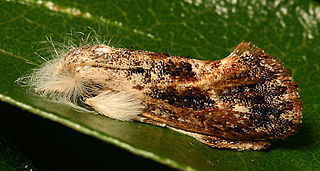
Leptocleidus is an extinct genus of plesiosaur, belonging to the family Leptocleididae.

Acrolophus is a genus of moths in the family Acrolophidae, with, typically, great individual variation within species in color pattern, making field identification of many individuals difficult or impossible. It was described by Felipe Poey in 1832.
The Bangweulu tsessebe is a subspecies of antelope found in northeastern Zambia. The tsessebes in northeastern Zambia in the southern Bangweulu Flats are classified by Naturalist F. Cotterill as a new species based on differences in pelage and cranial morphology.

Acrolophus popeanella is a moth of the family Acrolophidae. It is found in the eastern United States, from New Jersey and Ohio south to Florida and west to Illinois, Nebraska and Texas.
Acrolophus fervidus is a moth of the family Acrolophidae described by August Busck in 1912. It is found in Costa Rica, Mexico and Texas.

Acrolophus arcanella is a moth of the family Acrolophidae. It is found in eastern North America.
Acrolophus arcasalis is a moth of the family Acrolophidae. It is found in the West Indies.
Acrolophus salvini is a moth of the family Acrolophidae first described by Herbert Druce in 1901. It is found in Panama.

Acrolophus texanella is a moth of the family Acrolophidae. It is found from Maryland to Florida and to Texas.
Acrolophus macrogaster is a moth of the family Acrolophidae. It is found in North America, including Arizona.
Acrolophus propinqua is a moth of the family Acrolophidae. It is found in North America, including Alabama, Florida, Georgia, Illinois, Louisiana, Maryland, Mississippi, New York, Ohio, South Carolina, Tennessee, Virginia and West Virginia.
Acrolophus cockerelli is a moth of the family Acrolophidae. It is found in North America, including Arizona, Nevada, New Mexico, Oklahoma, Oregon and Texas.
Acrolophus echinon is a moth of the family Acrolophidae. It is found in Mexico.
Acrolophus harparsen is a moth of the family Acrolophidae. It is found in Puerto Rico.
Acrolophus mimasalis is a moth of the family Acrolophidae. It is found in the West Indies.
Acrolophus maculata is a moth of the family Acrolophidae. It is found in Brazil.
Acrolophus numidia is a moth of the family Acrolophidae first described by Herbert Druce in 1901. It is found in Mexico.
Acrolophus satyrisca is a moth of the family Acrolophidae. It is found in Colombia.
Acrolophus walsinghami is a moth of the family Acrolophidae. It is found in Puerto Rico.
Millsodon is a member of the order Haramiyida, which lived during the Late Bathonian in Dorset and Oxfordshire. There are three sorts known, all with molariform teeth, of which BM(NH) M46645 is the holotype and BMNH M46183 is the paratype; an assigned specimen is BDUC J 3. The only species, M. superstes, was described by Percy M. Butler & Jerry J. Hooker in 2005. The genus is named after the late Professor John R. E. Mills, who contributed a lot to the interpretation of Mesozoic mammalian teeth and was one of the original authors of the paratype, with the Greek word οδους, οδοντος (tooth). The species designation, 'superstes', is Latin for 'survivor'. It is still unclear to which family Millsodon belongs.




